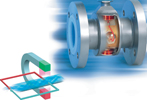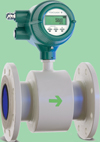
Water for drinking, washing, flushing and cooling - the ways of using this valuable natural resource are almost unlimited. But the economical use of water is playing an increasingly important role in the industrialised countries. The RXF magnetic inductive flowmeter is a measuring system which was specially developed to measure volumes of water and sewage, and to meet the requirements of these sectors.
The recognition of every leak starts with the complete capture of all flow rates. This requires a precise and reliable measuring system as well as undamaged water mains. A look at Japan tells us what has to be done to recognise and rectify leaks quickly. Japan has a modern system of water mains but also has frequent earthquakes which continuously cause leaks. Yokogawa magnetic induction flowmeters (MID) are used to monitor the water mains. This method of measurement is reliable and exact even when flow rates vary significantly.
For stringent requirements
Today, more is expected from flow measurement than an approximate statement of volumes. Flow measurement by magnetic induction offers many advantages as constrictions and obstructions which can influence precise measurement are not present in the flow of the process medium (Figure 1). In addition, the sensor is protected by a coating from the process medium and the corrosive, aggressive or adhesive substances it may contain. Thus the user of the RXK series MID obtains very precise values for the water flow with a conductivity starting from 5 μs/cm. The maximum deviation from the measured value is ±0,5%; the accuracy is normally significantly better. The reproducibility of the measurement is usually 0,05% of the measured value. This applies across the whole range of flows from 0 to 28 000 m³/h and nominal diameters from DN15 to DN1000. Also the materials used to manufacture the parts of the RXF in contact with the medium are specially selected for use with water and sewage. Stainless steel type 316L/1.4404 and Hastelloy C276/2.4819 are used for the electrodes. The coating material is hard rubber and meets the DVGW (The German Technical and Scientific Association for Gas and Water) drinking water test which checks the hygiene and mechanical behaviour of the MID when used in water. Resistance to bacteria and electrode anchorages as well as the workmanship and processing of the coating material are also tested and approved.

The short, unobstructed inflow and outflow sections of the RXF are also subject to the NAMUR Requirements. Under normal circumstances 5D in the inlet is perfectly adequate for precise measurement and at the outlet even 0D is permissible; this means that there is no need for any uninterrupted discharge section. It is only necessary to provide 10D at the inlet and 2D at the outlet in exceptional circumstances, for example if there are valves before and after the measuring equipment.
When used for water, the temperatures of the process medium are normally in the acceptable range (up to 90°C). In the case of sewage treatment plants, the measurement locations can also be in the open air and are subject to intemperate environmental conditions. The RXF has been equipped for open-air operation by its IP 67 protective system and its suitability for operation at ambient temperatures between -40 and +60°C at 95% relative humidity; it needs only a light cover to protect it from direct sunlight.
Versatile evaluation electronics
The electronic evaluation system offers a wide range of functions. The measuring signal can be output via a 4-20 mA/Hart output, a Foundation Fieldbus interface or an impulse output for measuring the volume. Depending on the setting, the current or total flow can be displayed on the local full dot matrix LC display as a percentage figure or in physical units either in number or graphical form. The display also shows alarm messages in clear text form along with a description of the measures to be implemented.
The equipment is parameterised without the need to open the case via a wear-free protected infra-red switch (touch-through-glass) with an IP 67 protective system (Figure 2). Two digital outputs allow transmission of alarms about limit violations, status or self-diagnosis reports, electrode deposits or an incompletely filled tube to external equipment such as rotating fleshing lights or hooters.

Built in self-diagnosis
More than an accurate measuring system is needed to obtain precise and reliable data about the process parameter 'flow'. RFX, as well as presenting a straightforward reading, also provides information on its status so that the operator or the host system can recognise whether the reading is valid or deficient. This function cannot be obtained with the 4-20 mA signal but is standard with modern communication protocols such as Hart and Brain or fieldbuses such as the Foundation Fieldbus. The modern measuring system also checks and issues reports on its own status and that of the process environment so that a short circuit or a cable break is just a readily recognised as a sensor covered by a deposit or an empty tube. Modern measuring instruments like RXF provide information that is unobtainable unless the measuring transducer is equipped with powerful electronic systems.
How precise must it be?
We have to ask the question: ‘Do we need such precision?’ In these days of modern environmental management and demanding sewage regulations, more advanced technical solutions are necessary. Admittedly, sewers with a defined geometry are used in some applications handling relatively large volumes, for example at the entry point into sewage treatment plants. In such cases the flow can be calculated without the need for precision from the extent to which the sewer is filled. However, where the calculation has to be more precise, for example at the discharge end of sewage treatment plants, in drinking water supplies or industrial plants, simple mechanical or hydraulic equipment is no longer sensible. In these areas each cubic metre is often billed; a lot of money is therefore at stake.
| Tel: | +27 11 831 6300 |
| Email: | [email protected] |
| www: | www.yokogawa.com/za |
| Articles: | More information and articles about Yokogawa South Africa |

© Technews Publishing (Pty) Ltd | All Rights Reserved